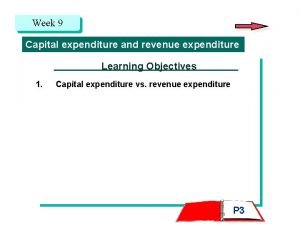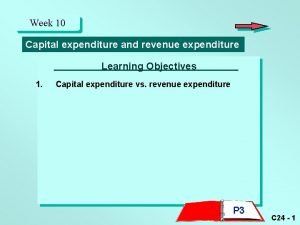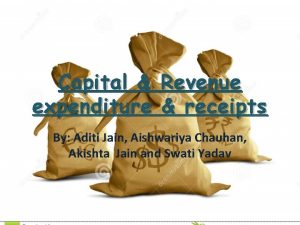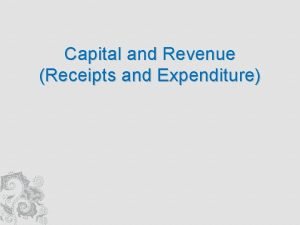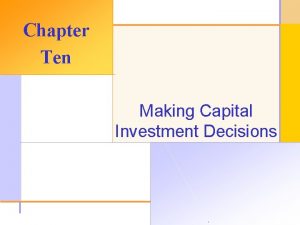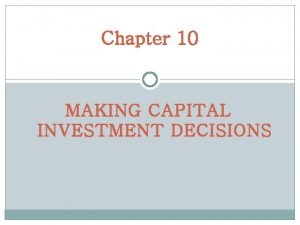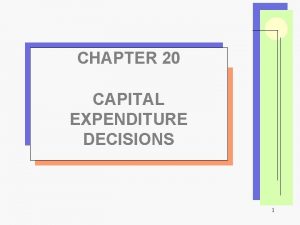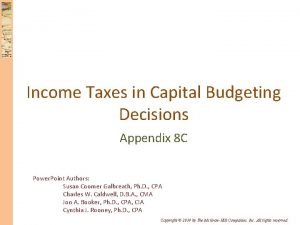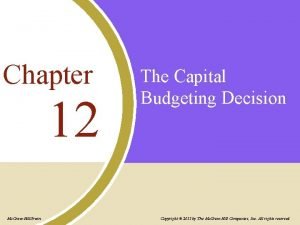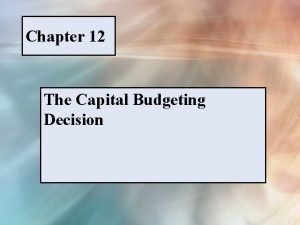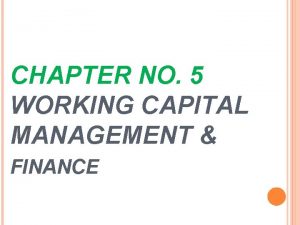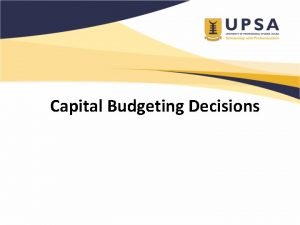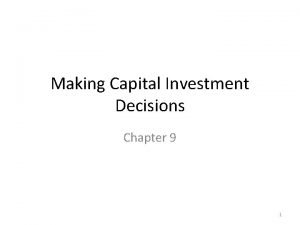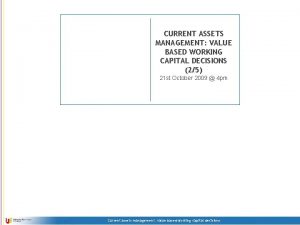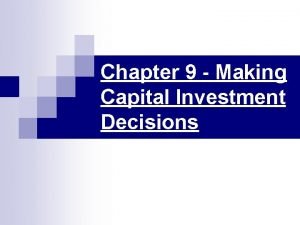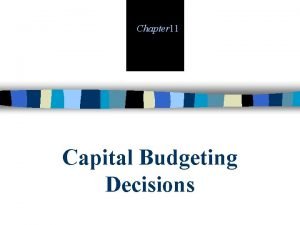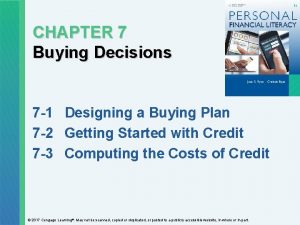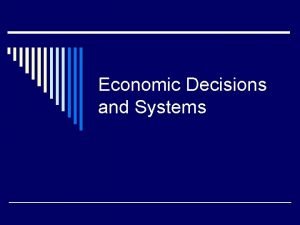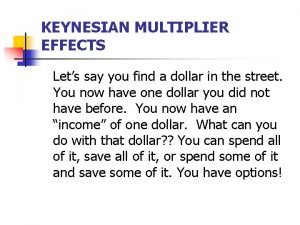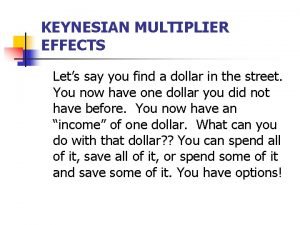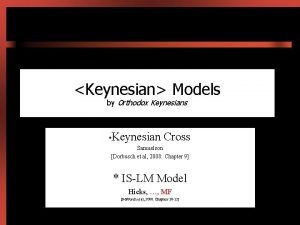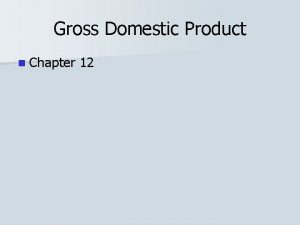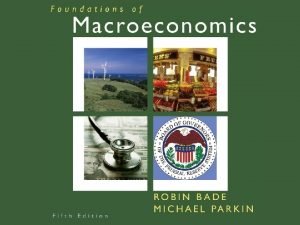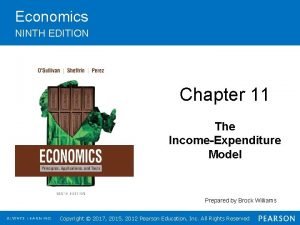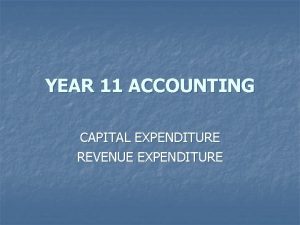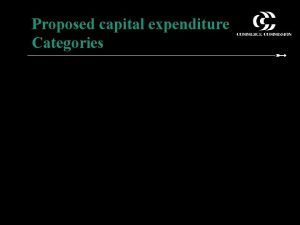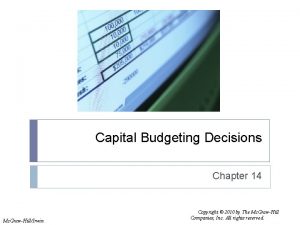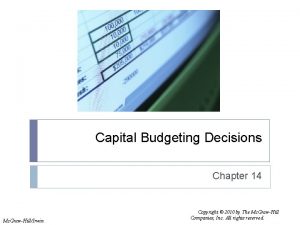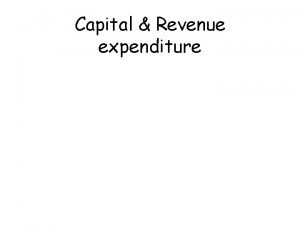Chapter 16 Capital Expenditure Decisions Mc GrawHillIrwin Copyright




















































- Slides: 52

Chapter 16 Capital Expenditure Decisions Mc. Graw-Hill/Irwin Copyright © 2011 by The Mc. Graw-Hill Companies, Inc. All rights reserved.

Learning Objective 1 16 -

Discounted-Cash-Flow Analysis Plant expansion Equipment selection Cost reduction Equipment replacement Lease or buy 16 -3

Net-Present-Value Method o o Prepare a table showing cash flows for each year, Calculate the present value of each cash flow using a discount rate, Compute net present value, If the net present value (NPV) is positive, accept the investment proposal. Otherwise, reject it. 16 -4

Net-Present-Value Method Mattson Co. has been offered a five year contract to provide component parts for a large manufacturer. 16 -5

Net-Present-Value Method • At the end of five years the working capital will be released and may be used elsewhere by Mattson. • Mattson uses a discount rate of 10%. Should the contract be accepted? 16 -6

Net-Present-Value Method Annual net cash inflows from operations 16 -7

Net-Present-Value Method Mattson should accept the contract because the present value of the cash inflows exceeds the present value of the cash outflows by $85, 955. The project has a positive net present value. 16 -8

Internal-Rate-of-Return Method • The internal rate of return is the true economic return earned by the asset over its life. • The internal rate of return is computed by finding the discount rate that will cause the net present value of a project to be zero. 16 -9

Internal-Rate-of-Return Method • Black Co. can purchase a new machine at a cost of $104, 320 that will save $20, 000 per year in cash operating costs. • The machine has a 10 -year life. 16 -10

Internal-Rate-of-Return Method Future cash flows are the same every year in this example, so we can calculate the internal rate of return as follows: Investment required Net annual cash flows $104, 320 $20, 000 = Present value factor = 5. 216 16 -11

Internal-Rate-of-Return Method The present value factor (5. 216) is located on the Table IV in the Appendix. Scan the 10 period row and locate the value 5. 216. Look at the top of the column and you find a rate of 14% which is the internal rate of return. $104, 320 $20, 000 = 5. 216 16 -12

Internal-Rate-of-Return Method Here’s the proof. . . 16 -13

Learning Objective 2 16 -

Comparing the NPV and IRR Methods Net Present Value v The cost of capital is used as the actual discount rate. v Any project with a negative net present value is rejected. Internal Rate of Return v The cost of capital is compared to the internal rate of return on a project. v To be acceptable, a project’s rate of return must be greater than the cost of capital. 16 -15

Comparing the NPV and IRR Methods The net present value method has the following advantages over the internal rate of return method. . . 4 Easier to use. 4 Easier to adjust for risk. 16 -16

Assumptions Underlying Discounted-Cash-Flow Analysis All cash flows are treated as though they occur at year end. Cash flows are treated as if they are known with certainty. Assumes a perfect capital market. Cash inflows are immediately reinvested at the required rate of return. 16 -17

Choosing the Hurdle Rate • The discount rate generally is associated with the company’s cost of capital. • The cost of capital involves a blending of the costs of all sources of investment funds, both debt and equity. 16 -18

Learning Objective 3 16 -

Comparing Two Investment Projects To compare competing investment projects we can use the following net present value approaches: – Total-Cost Approach. – Incremental-Cost Approach. 16 -20

Total-Cost Approach • Each system would last five years. • 12 percent hurdle rate for the analysis. MAINFRAME PC _ Salvage value old system $ 25, 000 Cost of new system (400, 000) (300, 000) Cost of new software ( 40, 000) ( 75, 000) Update new system ( 40, 000) ( 60, 000) Salvage value new system 50, 000 30, 000 ======================== Operating costs over 5 -year life: Personnel (300, 000) (220, 000) Maintenance ( 25, 000) ( 10, 000) Other costs ( 10, 000) ( 5, 000) Datalink services ( 20, 000) Revenue from time-share 25, 000 - 16 -21

Total-Cost Approach MAINFRAME ($) Acquisition cost computer Acquisition cost software System update Salvage value Operating costs Time sharing revenue Total cash flow X Discount factor Present value Today (400, 000) ( 40, 000) Year 1 Year 2 Year 3 Year 4 Year 5 ( 40, 000) (335, 000) 20, 000 440, 000 X 1. 000 (440, 000) 50, 000 (335, 000) (335, 000) 20, 000 20, 000 (315, 000) (355, 000) (315, 000) (265, 000) X. 893 X. 797 X. 712 X. 636 X. 567 (281, 295) (251, 055) (252, 760) (200, 340) (150, 255) SUM = ($1, 575, 705) PERSONAL COMPUTER ($) Today Year 1 Year 2 Year 3 Year 4 Year 5 Acquisition cost computer (300, 000) Acquisition cost software ( 75, 000) System update ( 60, 000) Salvage value 50, 000 Operating costs (235, 000) (235, 000) Time sharing revenue -0 -0 -0_ Total cash flow 375, 000 (235, 000) (295, 000) (235, 000) (205, 000) X Discount factor X 1. 000 X. 893 X. 797 X. 712 X. 636 X. 567 Present value (375, 000) (209, 855) (187, 295) (210, 040) (149, 460) (116, 235) SUM = ($1, 247, 885) 16 -22

Total-Cost Approach Net cost of purchasing Mainframe system ($1, 575, 705) Net cost of purchasing Personal Computer system ($1, 247, 885) Net Present Value of costs ($ 327, 820) Mountainview should purchase the personal computer system for a cost savings of $327, 820. 16 -23

Incremental-Cost Approach INCREMENTAL ($) Acquisition cost computer Acquisition cost software System update Salvage value Operating costs Time sharing revenue Total cash flow X Discount factor Present value Today (100, 000) 35, 000 Year 1 Year 2 Year 3 Year 4 Year 5 20, 000 ( 65, 000) X 1. 000 ( 65, 000) 20, 000 (100, 000) (100, 000) 20, 000 20, 000 ( 80, 000) ( 60, 000) X. 893 X. 797 X. 712 X. 636 X. 567 ( 71, 440) ( 63, 760) ( 42, 720) ( 50, 880) ( 34, 020) SUM = ($ 327, 820) 16 -24

Total-Incremental Cost Comparison Total Cost: Net cost of purchasing Mainframe system ($1, 575, 705) Net cost of purchasing Personal Computer system ($1, 247, 885) Net Present Value of costs ($ 327, 820) Incremental Cost: Net Present Value of costs ($ 327, 820) Different methods, Same results. 16 -25

Managerial Accountant’s Role Managerial accountants are often asked to predict cash flows related to operating cost savings, additional working capital requirements, and incremental costs and revenues. When cash flow projections are very uncertain, the accountant may. . . 1. increase the hurdle rate, 2. use sensitivity analysis. 16 -26

Postaudit of Investment Projects A postaudit is a follow-up after the project has been approved to see whether or not expected results are actually realized. 16 -27

Learning Objective 4 16 -

Income Taxes and Capital Budgeting Cash flows from an investment proposal affect the company’s profit and its income tax liability. Income = Revenue - Expenses + Gains - Losses 16 -29

After-Tax Cash Flows High Country Department Stores Income Statement For the Year Ended Jun 30, 2007 Revenue $ 1, 000 Expenses Income before taxes Income taxes Net Income (475, 000) 525, 000 (210, 000) 315, 000 The tax rate is 40%, so income taxes are $525, 000 × 40% = $ 210, 000 Not all expenses require cash outflows. The most common example is depreciation. 16 -30

Learning Objective 5 16 -

Modified Accelerated Cost Recovery System (MACRS) Tax depreciation is usually computed using MACRS. Here are the depreciation rate for 3, 5, and 7 -year class life assets. 16 -32

Learning Objective 6 16 -

Investment in Working Capital Some investment proposals require additional outlays for working capital such as increases in cash, accounts receivable, and inventory. 16 -34

Extended Illustration For a complete present value analysis for an investment decision facing High Country Department Stores, Inc. , see the textbook. High Country Department Stores 16 -35

Learning Objective 7 16 -

Ranking Investment Projects We can invest in either of these projects. Use a 10% discount rate to determine the net present value of the cash flows. The total cash flows are the same, but the pattern of the flows is different. 16 -37

Ranking Investment Projects Let’s calculate the present value of the cash flows associated with Project A. This project has a positive net present value which means the project’s return is greater than the discount rate. 16 -38

Ranking Investment Projects Here is the net present value of the cash flows associated with Project B has a negative net present value which means the project’s return is less than the discount rate. 16 -39

Learning Objective 8 16 -

Alternative Methods for Making Investment Decisions Payback Method Payback Initial investment = period Annual after-tax cash inflow A company can purchase a machine for $20, 000 that will provide annual cash inflows of $4, 000 for 7 years. Payback = period $20, 000 $4, 000 = 5 years 16 -41

Payback: Pro and Con 1. Fails to consider the time value of money. 2. Does not consider a project’s cash flows beyond the payback period. 1. Provides a tool for roughly screening investments. 2. For some firms, it may be essential that an investment recoup its initial cash outflows as quickly as possible. 16 -42

Accounting-Rate-of-Return Method Discounted-cash-flow method focuses on cash flows and the time value of money. Accounting-rate-of-return method focuses on the incremental accounting income that results from a project. 16 -43

Accounting-Rate-of-Return Method The following formula is used to calculate the accounting rate of return: Accounting rate of return = Average incremental revenues - Average incremental expenses, including depreciation & income taxes Initial investment 16 -44

Accounting-Rate-of-Return Method Meyers Company wants to install an espresso bar in its restaurant. The espresso bar: – Cost $140, 000 and has a 10 -year life. – Will generate incremental revenues of $100, 000 and incremental expenses of $80, 000 including depreciation. What is the accounting rate of return on the investment project? 16 -45

Accounting-Rate-of-Return Method Accounting = rate of return $100, 000 - $80, 000 $140, 000 = 14. 3% The accounting rate of return method is not recommended for a variety of reasons, the most important of which is that it ignores the time value of money. 16 -46

Learning Objective 9 16 -

Estimating Cash Flows: The Role of Activity-Based Costing ABC systems generally improve the ability of an analyst to estimate the cash flows associated with a proposed project. 16 -48

Justification of Investments in Advanced Manufacturing Systems Time horizons are too short Hurdle rates are too high Benefits difficult to quantify Bias towards incremental projects Greater cash flow uncertainty 16 -49

Learning Objective 10 16 -

Inflation Effects Nominal Dollars Real dollars 16 -51

End of Chapter 16 16 -52
 Capital expenditure and revenue expenditure
Capital expenditure and revenue expenditure Examples of revenue expenditure
Examples of revenue expenditure What is capital receipt
What is capital receipt Capital and revenue expenditure
Capital and revenue expenditure Meaning of poster making
Meaning of poster making Cca tax shield calculator
Cca tax shield calculator Nwc change
Nwc change Screening decisions and preference decisions
Screening decisions and preference decisions Capital expenditure decision are
Capital expenditure decision are Advantages of capital expenditure
Advantages of capital expenditure Capital and revenue expenditure
Capital and revenue expenditure How to calculate depreciation tax shield
How to calculate depreciation tax shield Capital budgeting decisions emphasize flows.
Capital budgeting decisions emphasize flows. Capital budgeting decisions ppt
Capital budgeting decisions ppt Working capital financing approaches
Working capital financing approaches Making capital investment decisions
Making capital investment decisions Capital budgeting process
Capital budgeting process Nwc change
Nwc change Working capital decisions
Working capital decisions Making capital investment decisions
Making capital investment decisions Typical capital budgeting decisions include
Typical capital budgeting decisions include Payback chapter 14
Payback chapter 14 Working capital introduction
Working capital introduction Difference between capital reserve and reserve capital
Difference between capital reserve and reserve capital Multinational capital structure
Multinational capital structure Difference between capital reserve and reserve capital
Difference between capital reserve and reserve capital Basle ii
Basle ii Regulatory capital vs economic capital
Regulatory capital vs economic capital Constant and variable capital
Constant and variable capital Multinational cost of capital and capital structure
Multinational cost of capital and capital structure Capital allocation line vs capital market line
Capital allocation line vs capital market line Chapter 4 financial decisions and planning
Chapter 4 financial decisions and planning Chapter 4 financial decisions and planning
Chapter 4 financial decisions and planning Chapter 7 buying decisions
Chapter 7 buying decisions Chapter 7 buying decisions
Chapter 7 buying decisions Loan vocabulary
Loan vocabulary Chapter 1 economic decisions and systems answer key
Chapter 1 economic decisions and systems answer key Chapter 4 financial decisions and planning
Chapter 4 financial decisions and planning Chapter 4 financial decisions and planning
Chapter 4 financial decisions and planning Chapter 4 financial decisions and planning
Chapter 4 financial decisions and planning National income formula
National income formula Tax multiplier formula
Tax multiplier formula How gdp is calculated
How gdp is calculated National income data
National income data How to calculate the tax multiplier
How to calculate the tax multiplier Gov spending multiplier
Gov spending multiplier Autonomous expenditure formula
Autonomous expenditure formula Government spending multiplier
Government spending multiplier What is government expenditure multiplier
What is government expenditure multiplier Capital deepening examples
Capital deepening examples Income method gdp formula
Income method gdp formula Government expenditure formula
Government expenditure formula The equilibrium level of real gdp
The equilibrium level of real gdp
